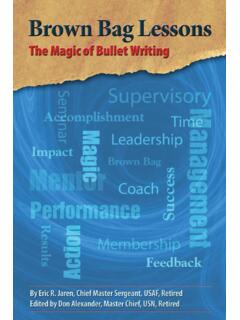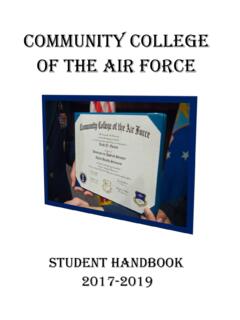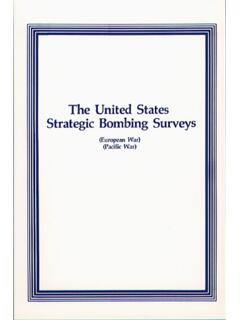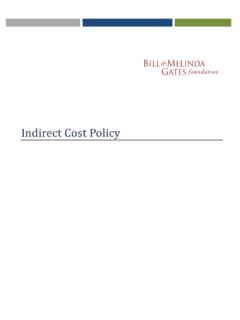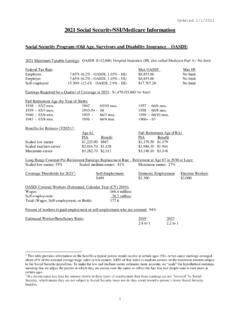Transcription of Command and Control of Operations in the Information ...
1 AIR & SPACE POWER JOURNAL - SENIOR LEADER PERSPECTIVE. Command and Control of Operations in the Information Environment Leading with Information in operational Planning, Execution, and Assessment Sandeep S. Mulgund, PhD. Gen Mark D. Kelly, USAF. Disclaimer: The views and opinions expressed or implied in the Journal are those of the authors and should not be construed as carrying the official sanction of the Department of Defense, Air Force, Air Education and Training Command , Air University, or other agencies or departments of the US government. This article may be reproduced in whole or in part without permission. If it is reproduced, the Air and Space Power Journal requests a courtesy line.
2 Introduction A broad range of Department of Defense strategic guidance has highlighted the increasing importance of leveraging Information to creating enduring strate- gic outcomes from joint force tactical and operational Advances in Information technology are increasing the reach, speed, and effectiveness with which humans acquire, process, and transfer Information . State and nonstate ad- versaries, increasingly unable to challenge the joint force through conventional military power, are using Information to gain an advantage over the joint force and impede the achievement of US strategic objectives. The joint force must de- velop, operationalize, and institutionalize an effective approach for wielding in- formation in concert with traditional physical military power to compete success- fully in this environment.
3 AIR & SPACE POWER JOURNAL WINTER 2020 15. Mulgund & Kelly Recognizing its criticality in Joint Operations , the 2018 update to Joint Publica- tion 3-0, Joint Operations introduced Information as the seventh joint Joint functions are related capabilities grouped together to enable joint force com- manders ( JFC) to integrate, synchronize, and direct joint Operations . The infor- mation function encompasses the management and application of Information and its deliberate integration with other joint functions to change or maintain perceptions, attitudes, and other elements that drive desired behaviors and sup- port human and automated decision- making.
4 Information can be used as an in- strument to affect the behavior of relevant actors, which may include any individu- als, groups, and populations, or any automated systems whose actions have the potential to substantially help or hinder the success of a particular military activity. As described in JP 3-0,3 the specific uses of Information to affect perceptions, at- titudes, and behaviors include: 1. Informing domestic and international audiences through the release of accurate Information to put Operations in context 2. Influencing relevant actors (not including US audiences) to change or maintain behaviors 3. Attacking and exploiting Information , Information networks, and infor- mation systems The Joint Concept for Operations in the Information Environment ( JCOIE).
5 Argues that the joint force must understand how to manipulate and leverage in- formation and the inherent informational aspects of activities to send deliberate All Joint force actions, written or spoken words, or displayed or re- lated images have informational aspects that communicate some message or in- tent, which can be leveraged to support the achievement of Joint force objectives. The JCOIE describes the construct of informational power as the ability to lever- age Information to shape perceptions, attitudes, and other elements that drive desired behavior and the course of events. It establishes the imperative to opera- tionalize and institutionalize the integration of Information with traditional military physical Figure 1 illustrates the overall context for Operations in the Information envi- ronment (OIE) and the application of Information , as discussed above.
6 Advanc- ing US national interests across the diplomatic, Information , military, and eco- nomic instruments of national power require affecting relevant actor perceptions and behaviors in a structured manner. This impact happens through Operations , activities, and investments (OAI) that may be overt, covert, or clandestine in nature. The intent of those OAIs is to shape the operating environment across 16 AIR & SPACE POWER JOURNAL WINTER 2020. Command and Control of Operations in the Information Environment the competition continuum. The results of those OAIs are evaluated through ongoing feedback and assessment mechanisms, which are used to calibrate and refine strategic approaches.
7 In order to advance our interests with American people In order to We must Through That Evaluated through . Allies and partners Operations , Affect relevant Shape the Ongoing Advance our activities, and Diplomatic actor perceptions operating feedback and national interests investments Information and behaviors environment assessments (OAIs). Military Economic We mustWith . affect relevant actor perceptions and behaviors to Which may be In To learn . To . assure deter American Assure Overt Cooperation Are we doing people things right? induce Deter Covert Competition compel Allies and Are we doing Through Operations , activities, and investments (OAIs) which may be partners Induce Clandestine Conflict the right overt things?
8 Covert Compel Across . clandestine Are we That shape the Diplomatic operating environment in measuring cooperation the right Information competition things? conflict Military Are we Evaluated through ongoing feedback and assessments to learn advancing the Are we doing things right? campaign? Economic Are we doing the right things>. Are we measuring the right things? Are we advancing the campaign? How should we identify, prioritize, plan, execute, and assess OAIs to advance these How should we identify, prioritize, plan, execute, and assess OAIs to advance these objectives? objectives? Figure 1. Context for Operations in the Information environment The Department of the Air Force has recognized the challenges and opportu- nities associated with gaining and maintaining Information advantage, particu- larly through the Sixteenth Air Force (AF) standup as an Information Warfare Numbered Air Force.
9 A challenge within the Air Force is that existing constructs for operational - level Command and Control (C2) (planning, execution, and as- sessment) do not directly place shaping perceptions and behaviors at the fore- front of component activities. This procedure often relegates informational con- siderations to the end of planners' checklists or treating Information Operations . as the realm of specialty teams rather than something central to commander's business. Existing force structures, training programs, and associated Command relationships are not designed to facilitate the effective integration of informa- tional power considerations into operational - level C2, which is oriented to the air tasking cycle for combat Operations .
10 This approach described in this article seeks to address these challenges by defining approaches to placing Information at the forefront of air and space component operational planning, execution, and assessment processes and approaches. It complements the approach described by General Reynolds to develop an organizational structure for Information warfare at Sixteenth AIR & SPACE POWER JOURNAL WINTER 2020 17. Mulgund & Kelly Conceptual framework Figure 2 below presents the overall C2 OIE conceptual framework, the purpose of which is to establish how to incorporate the joint function of Information into operational - level planning, execution, and assessment (1) Competition Continuum Cooperation Competition Conflict Engage selectively, maintain, advance Improve, counter, contest Deny, degrade, defeat (2) Information in campaign design (3) Desired effects on relevant (4)

